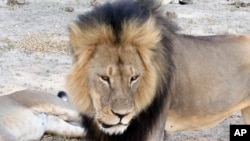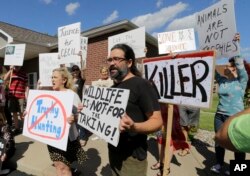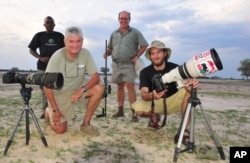When Cecil the lion's carcass was finally found after he was lured out of a Zimbabwe wildlife reserve to be killed by an American hunter, it was a headless, skinless skeleton the vultures had been picking at for about a week.
Conservationists decided the most natural thing was to leave the bones where they were for hyenas to finish off, said Brent Stapelkamp, a lion researcher and part of a team that had tracked and studied Cecil for nine years.
Stapelkamp darted Cecil and put his last GPS collar on in October. He was probably the last person to get up close before Minnesota dentist Walter Palmer used a bow and a gun to kill the now-famous lion with the bushy black mane, its head and skin eventually cut off as trophies.
Stapelkamp had first alerted authorities that something might be wrong after Cecil's GPS collar stopped sending a signal.
Anger at lion's killing
The killing of the big cat in early July has unleashed global outrage, sending Palmer into hiding back home in suburban Minneapolis, leading to the arrest of the local hunter he employed, and prompting Zimbabwe's environment minister to say the southern African country would seek Palmer's extradition to face charges.
Stapelkamp shares the anger, not just because of the demise of Cecil. Also because, he said, it's not the first time a lion has been killed illegally around Hwange National Park in northwestern Zimbabwe, a reserve known for its rich wildlife. About a dozen lions in the region were killed illegally in recent years, Stapelkamp said, and no one was caught.
“I think this was just the final straw,” Stapelkamp told The Associated Press in a phone interview from the Hwange reserve. “Everyone locally just thought, no ways, we're not letting anyone get away with this anymore.”
Cecil had an intriguing story, making him a celebrity in Hwange. He arrived as a kind of lion refugee, alone and wandering after being displaced from another territory. Cecil befriended another male lion, Jericho, and together they grew and watched over two prides, one with three lionesses and seven cubs and another with three lionesses.
Impact larger than one lion
Cecil's killing will have an impact on the area, explained Stapelkamp, a field researcher for an Oxford University study on lions.
Jericho may not be able to hold their territory alone and could be chased away by rival lions. Unprotected, the lionesses and cubs would then be under threat and also move away or be killed. Safari operators who invested millions of dollars in the area would lose one of their biggest attractions for tourists.
“They're burning fire breaks. They're grading roads. They're pumping water,” Stapelkamp said. “They're spending a lot of money in the management of lions and then someone just draws it across the railway lines having not paid a penny in its management and shoots it and runs away with its skin. It's unacceptable.”
Zimbabwe's National Parks and Wildlife Authority said Saturday said it has suspended the hunting of lions, leopards and elephants outside of Hwange National Parks, and that bow and arrow hunts have also been suspended unless they are approved by the authority's director.
The authority also said it is investigating the killing of another lion in April that may have been illegal.
Stapelkamp, unsure of the details of Cecil's killing, described the usual tactics of hunters to draw an animal onto private land and out of the park where it is protected. The two areas are separated by a railway line. Hunters shoot a zebra or giraffe and hang it on a tree; the main bait. They then drag the intestines of that animal, “something that really smells,” Stapelkamp said, up and down the park boundary behind a vehicle. Sometimes they'll even play the sounds of a dying buffalo over a loudspeaker to attract a lion.
The lion “comes across that scent trail and it leads him straight to this bait,” Stapelkamp said. “It rushes in for a free meal and they're waiting ... and they kill him like that.”
Dentist's story doubted
Even on private land, this hunt was still illegal, Stapelkamp said, because no hunting quotas for lions were issued in the region this year. Legal hunts do happen, he said, but only after authorities consult with ecologists and decide that it won't adversely affect the area.
This didn't happen with Cecil, Stapelkamp said, and he doesn't believe Palmer's story that he trusted his professional guide to ensure a legal hunt.
“He's a well-educated man, he's got a lot of resources,” Stapelkamp said. “You could do your homework. Due diligence. You would know that you're hunting in a controversial area. You've got a GPS you could have in your pocket and you have a look at the map, and you say, `listen, friend, I think we're in the wrong area.' There's no excuse.”
Palmer came “with the intention of getting the biggest lion that he could and getting out. And he got caught,” Stapelkamp said.










